Did some research and found this article:
Convert Latitude/Longitude (Lat/Long) to Geography Point
So as given in article, I've created table and inserted some test data using given script:
CREATE TABLE [dbo].[Landmark] (
[ID] INT IDENTITY(1, 1),
[LandmarkName] VARCHAR(100),
[Location] VARCHAR(50),
[Latitude] FLOAT,
[Longitude] FLOAT
)
GO
INSERT INTO [dbo].[Landmark] ( [LandmarkName], [Location], [Latitude], [Longitude] )
VALUES ( 'Statue of Liberty', 'New York, USA', 40.689168,-74.044563 ),
( 'Eiffel Tower', 'Paris, France', 48.858454, 2.294694),
( 'Leaning Tower of Pisa', 'Pisa, Italy', 43.72294, 10.396604 ),
( 'Great Pyramids of Giza', 'Cairo, Egypt', 29.978989, 31.134632 ),
( 'Sydney Opera House', 'Syndey, Australia', -33.856651, 151.214967 ),
( 'Taj Mahal', 'Agra, India', 27.175047, 78.042042 ),
( 'Colosseum', 'Rome, Italy', 41.890178, 12.492378 )
GO
And then added calculated column using this query:
ALTER TABLE [dbo].[Landmark]
ADD [GeoLocation] AS geography::STPointFromText('POINT(' + CAST([Longitude] AS VARCHAR(20)) + ' ' + CAST([Latitude] AS VARCHAR(20)) + ')', 4326)
GO
Now when I query table using
SELECT *
FROM dbo.Landmark
I'm getting calculated spatial results too:

And results in axis:

Hopefully I understood you right.
Update:
I'm not sure if this will satisfy you. It's quite dirty, but it does the job:
That's how I formatted CSV file. I've used same structure as in previous example:
Statue of Liberty| New York, USA| 40.689168|-74.044563
Eiffel Tower| Paris, France| 48.858454| 2.294694
Leaning Tower of Pisa| Pisa, Italy| 43.72294| 10.396604
Great Pyramids of Giza| Cairo, Egypt| 29.978989| 31.134632
Sydney Opera House| Syndey, Australia| -33.856651| 151.214967
Taj Mahal| Agra, India| 27.175047| 78.042042
Colosseum| Rome, Italy| 41.890178| 12.492378
Columns seperator is | symbol and rows seperator is break symbol.
So what I did is, I used OPENROWSET to open CSV file and format this into rows instead having one long string( that's how OPENROWSET read my csv file, unfortunately). I've used this SplitString function:
https://stackoverflow.com/a/19935594/3680098
Now I need to turn these buddies into columns instead of one string. I've used this answer provided on SO: https://stackoverflow.com/a/15108499/3680098
Summing things up, that's the query:
SELECT LTRIM(RTRIM(xmlValue.value('/values[1]/value[1]','nvarchar(100)'))) AS LandmarkName
, LTRIM(RTRIM(xmlValue.value('/values[1]/value[2]','nvarchar(100)'))) AS Location
, LTRIM(RTRIM(xmlValue.value('/values[1]/value[3]','nvarchar(20)'))) AS Lon
, LTRIM(RTRIM(xmlValue.value('/values[1]/value[4]','nvarchar(20)'))) AS Lat
, GEOGRAPHY::STPointFromText('POINT(' + xmlValue.value('/values[1]/value[4]','nvarchar(20)') + ' ' + xmlValue.value('/values[1]/value[3]','nvarchar(20)') + ')', 4326)
FROM dbo.SplitString((SELECT Document.* FROM OPENROWSET(BULK N'C:\Temp\test.csv', SINGLE_CLOB) AS Document), CHAR(10)) AS T
CROSS APPLY (SELECT CAST('<values><value>' + REPLACE(T.Value, '|', '</value><value>') + '</value></values>' AS XML)) AS T1(xmlValue);
It generates me required data as in my first screenshot and it seems just fine.
So what I need to do, is to create my table and insert these into it:
CREATE TABLE [dbo].[Landmark] (
[ID] INT IDENTITY(1, 1),
[LandmarkName] VARCHAR(100),
[Location] VARCHAR(50),
[GeoLocation] GEOGRAPHY
)
GO
INSERT INTO dbo.Landmark (LandmarkName, Location, GeoLocation)
SELECT LTRIM(RTRIM(xmlValue.value('/values[1]/value[1]','nvarchar(100)'))) AS LandmarkName
, LTRIM(RTRIM(xmlValue.value('/values[1]/value[2]','nvarchar(100)'))) AS Location
, GEOGRAPHY::STPointFromText('POINT(' + xmlValue.value('/values[1]/value[4]','nvarchar(20)') + ' ' + xmlValue.value('/values[1]/value[3]','nvarchar(20)') + ')', 4326)
FROM dbo.SplitString((SELECT Document.* FROM OPENROWSET(BULK N'C:\Temp\test.csv', SINGLE_CLOB) AS Document), CHAR(10)) AS T
CROSS APPLY (SELECT CAST('<values><value>' + REPLACE(T.Value, '|', '</value><value>') + '</value></values>' AS XML)) AS T1(xmlValue)
Results:



